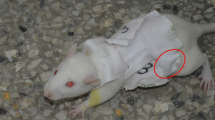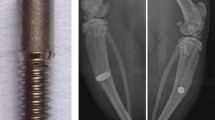Abstract
Summary
Variables defining vibration-based biomechanical treatments were tested by their ability to affect the musculoskeleton in the growing mouse. Duration of a vibration bout, but not variations in vibration intensity or number of vibration bouts per day, was identified as modulator of trabecular bone formation rates.
Introduction
Low-intensity vibrations (LIV) may enhance musculoskeletal properties, but little is known regarding the role that individual LIV variables play. We determined whether acceleration magnitude and/or the number and duration of daily loading bouts may modulate LIV efficacy.
Methods
LIV was applied to 8-week-old mice at either 0.3 g or 0.6 g for three weeks; the number of daily bouts was one, two, or four, and the duration of a single bout was 15, 30, or 60 min. A frequency of 45 Hz was used throughout.
Results
LIV induced tibial cortical surface strains in 4-month-old mice of approximately 10 με at 0.3 g and 30 με at 0.6 g. In trabecular bone of the proximal tibial metaphysis, all single daily bout signal combinations with the exception of a single 15 min daily bout at 0.3 g (i.e., single bouts of 30 and 60 min at 0.3 g and 15 and 30 min at 0.6 g) produced greater bone formation rates (BFR/BS) than in controls. Across all signal combinations, 30 and 60 min bouts were significantly more effective than 15 min bouts in raising BFR/BS above control levels. Increasing the number of daily bouts or partitioning a single daily bout into several shorter bouts did not potentiate efficacy and in some instances led to BFR/BS that was not significantly different from those in controls. Bone chemical and muscle properties were similar across all groups.
Conclusions
These data may provide a basis towards optimization of LIV efficacy and indicate that in the growing mouse skeleton, increasing bout duration from 15 to 30 or 60 min positively influences BFR/BS.




Similar content being viewed by others
References
Boreham CA, McKay HA (2011) Physical activity in childhood and bone health. Br J Sports Med 45:877–879
Kelley GA, Kelley KS, Kohrt WM (2012) Effects of ground and joint reaction force exercise on lumbar spine and femoral neck bone mineral density in postmenopausal women: a meta-analysis of randomized controlled trials. BMC Musculoskelet Disord 13:177
Nordstrom P, Sievanen H, Gustafson Y, Pedersen NL, Nordstrom A (2013) High physical fitness in young adulthood reduces the risk of fractures later in life in men: a nationwide cohort study. J Bone Miner Res 28:1061–1067
Gunter KB, Almstedt HC, Janz KF (2012) Physical activity in childhood may be the key to optimizing lifespan skeletal health. Exerc Sport Sci Rev 40:13–21
Clark EM, Ness AR, Tobias JH (2008) Vigorous physical activity increases fracture risk in children irrespective of bone mass: a prospective study of the independent risk factors for fractures in healthy children. J Bone Miner Res 23:1012–1022
Xie L, Jacobson JM, Choi ES, Busa B, Donahue LR, Miller LM, Rubin CT, Judex S (2006) Low-level mechanical vibrations can influence bone resorption and bone formation in the growing skeleton. Bone 39:1059–1066
Xie L, Rubin C, Judex S (2008) Enhancement of the adolescent murine musculoskeletal system using low-level mechanical vibrations. J Appl Physiol 104:1056–1062
Vanleene M, Shefelbine SJ (2013) Therapeutic impact of low amplitude high frequency whole body vibrations on the osteogenesis imperfecta mouse bone. Bone 53:507–514
Gilsanz V, Wren TA, Sanchez M, Dorey F, Judex S, Rubin C (2006) Low-level, high-frequency mechanical signals enhance musculoskeletal development of young women with low BMD. J Bone Miner Res 21:1464–1474
Ligouri GC, Shoepe TC, Almstedt HC (2012) Whole body vibration training is osteogenic at the spine in college-age men and women. J Hum Kinet 31:55–68
Lai C-L, Tseng S-Y, Chen C-N, Liao W-C, Wang C-H, Lee M-C, Hsu P-S (2013) Effect of 6 months of whole body vibration on lumbar spine bone density in postmenopausal women: a randomized controlled trial. Clin Interv Aging 8:1603
Ward K, Alsop C, Caulton J, Rubin C, Adams J, Mughal Z (2004) Low magnitude mechanical loading is osteogenic in children with disabling conditions. J Bone Miner Res 19:360–369
Reyes ML, Hernandez M, Holmgren LJ, Sanhueza E, Escobar RG (2011) High-frequency, low-intensity vibrations increase bone mass and muscle strength in upper limbs, improving autonomy in disabled children. J Bone Miner Res 26:1759–1766
Rubin C, Recker R, Cullen D, Ryaby J, McCabe J, McLeod K (2004) Prevention of postmenopausal bone loss by a low-magnitude, high-frequency mechanical stimuli: a clinical trial assessing compliance, efficacy, and safety. J Bone Miner Res 19:343–351
Brouwers JE, van Rietbergen B, Ito K, Huiskes R (2010) Effects of vibration treatment on tibial bone of ovariectomized rats analyzed by in vivo micro-CT. J Orthop Res 28:62–69
Slatkovska L, Alibhai SM, Beyene J, Hu H, Demaras A, Cheung AM (2011) Effect of 12 months of whole-body vibration therapy on bone density and structure in postmenopausal women: a randomized trial. Ann Intern Med 155(668–679):W205
Sen B, Xie Z, Case N, Styner M, Rubin CT, Rubin J (2011) Mechanical signal influence on mesenchymal stem cell fate is enhanced by incorporation of refractory periods into the loading regimen. J Biomech 44:593–599
Uzer G, Manske SL, Chan ME, Chiang FP, Rubin CT, Frame MD, Judex S (2012) Separating fluid shear stress from acceleration during vibrations in vitro: identification of mechanical signals modulating the cellular response. Cell Mol Bioeng 5:266–276
Uzer G, Pongkitwitoon S, Ian C, Thompson WR, Rubin J, Chan ME, Judex S (2014) Gap junctional communication in osteocytes is amplified by Low intensity vibrations in vitro. PLoS One 9:e90840
Christiansen BA, Silva MJ (2006) The effect of varying magnitudes of whole-body vibration on several skeletal sites in mice. Ann Biomed Eng 34:1149–1156
Judex S, Lei X, Han D, Rubin C (2007) Low-magnitude mechanical signals that stimulate bone formation in the ovariectomized rat are dependent on the applied frequency but not on the strain magnitude. J Biomech 40:1333–1339
Pasqualini M, Lavet C, Elbadaoui M, Vanden-Bossche A, Laroche N, Gnyubkin V, Vico L (2013) Skeletal site-specific effects of whole body vibration in mature rats: from deleterious to beneficial frequency-dependent effects. Bone 55:69–77
Holguin N, Uzer G, Chiang FP, Rubin C, Judex S (2011) Brief daily exposure to low-intensity vibration mitigates the degradation of the intervertebral disc in a frequency-specific manner. J Appl Physiol 111:1846–1853
Robling AG, Hinant FM, Burr DB, Turner CH (2002) Improved bone structure and strength after long-term mechanical loading is greatest if loading is separated into short bouts. J Bone Miner Res 17:1545–1554
DiPasquale DM, Cheng M, Billich W, Huang SA, van Rooijen N, Hornberger TA, Koh TJ (2007) Urokinase-type plasminogen activator and macrophages are required for skeletal muscle hypertrophy in mice. Am J Physiol Cell Physiol 293:C1278–C1285
Fritton SP, McLeod KJ, Rubin CT (2000) Quantifying the strain history of bone: spatial uniformity and self- similarity of low-magnitude strains. J Biomech 33:317–325
Dempster DW, Compston JE, Drezner MK, Glorieux FH, Kanis JA, Malluche H, Meunier PJ, Ott SM, Recker RR, Parfitt AM (2013) Standardized nomenclature, symbols, and units for bone histomorphometry: a 2012 update of the report of the ASBMR histomorphometry nomenclature committee. J Bone Miner Res 28:2–17
Liu C, Sanghvi R, Burnell JM, Howard GA (1987) Simultaneous demonstration of bone alkaline and acid phosphatase activities in plastic-embedded sections and differential inhibition of the activities. Histochemistry 86:559–565
Busa B, Miller LM, Rubin CT, Qin YX, Judex S (2005) Rapid establishment of chemical and mechanical properties during lamellar bone formation. Calcif Tissue Int 77:386–394
Bender R, Lange S (2001) Adjusting for multiple testing—when and how? J Clin Epidemiol 54:343–349
Rubin CT, Lanyon LE (1985) Regulation of bone mass by mechanical strain magnitude. Calcif Tissue Int 37:411–417
Rubin CT, Lanyon LE (1984) Regulation of bone formation by applied dynamic loads. J Bone Joint Surg Am 66:397–402
Cullen DM, Smith RT, Akhter MP (2001) Bone-loading response varies with strain magnitude and cycle number. J Appl Physiol 91:1971–1976
Garman R, Gaudette G, Donahue LR, Rubin C, Judex S (2007) Low-level accelerations applied in the absence of weight bearing can enhance trabecular bone formation. J Orthop Res 25:732–740
Uzer G, Pongkitwitoon S, Ete Chan M, Judex S (2013) Vibration induced osteogenic commitment of mesenchymal stem cells is enhanced by cytoskeletal remodeling but not fluid shear. J Biomech 46:2296–2302
Judex S, Rubin CT (2010) Is bone formation induced by high-frequency mechanical signals modulated by muscle activity? J Musculoskelet Neuronal Interact 10:3–11
Gross TS, McLeod KJ, Rubin CT (1992) Characterizing bone strain distributions in vivo using three triple rosette strain gages. J Biomech 25:1081–1087
Frost HM (1987) Bone “mass” and the “mechanostat”: a proposal. Anat Rec 219:1–9
Robling AG, Burr DB, Turner CH (2000) Partitioning a daily mechanical stimulus into discrete loading bouts improves the osteogenic response to loading. J Bone Miner Res 15:1596–1602
Gross TS, Poliachik SL, Ausk BJ, Sanford DA, Becker BA, Srinivasan S (2004) Why rest stimulates bone formation: a hypothesis based on complex adaptive phenomenon. Exerc Sport Sci Rev 32:9–13
Robling AG (2009) Is bone’s response to mechanical signals dominated by muscle forces? Med Sci Sports Exerc 41:2044–2049
Rizzoli R, Bianchi ML, Garabédian M, McKay HA, Moreno LA (2010) Maximizing bone mineral mass gain during growth for the prevention of fractures in the adolescents and the elderly. Bone 46:294–305
Acknowledgments
Funding by the US Army Medical Research and Material Command (DAMD 17-03-1-0777), the Department of Defense (DoD W81XWH-14-1-0281), and the National Institutes of Health (NBIB EB01435101A) was greatly appreciated.
Conflicts of interest
Stefan Judex and Timothy Koh own (provisional) patents regarding the application of vibrations to the musculoskeletal system. Liqin Xie has no conflict of interest.
Author information
Authors and Affiliations
Corresponding author
Rights and permissions
About this article
Cite this article
Judex, S., Koh, T.J. & Xie, L. Modulation of bone’s sensitivity to low-intensity vibrations by acceleration magnitude, vibration duration, and number of bouts. Osteoporos Int 26, 1417–1428 (2015). https://doi.org/10.1007/s00198-014-3018-5
Received:
Accepted:
Published:
Issue Date:
DOI: https://doi.org/10.1007/s00198-014-3018-5




